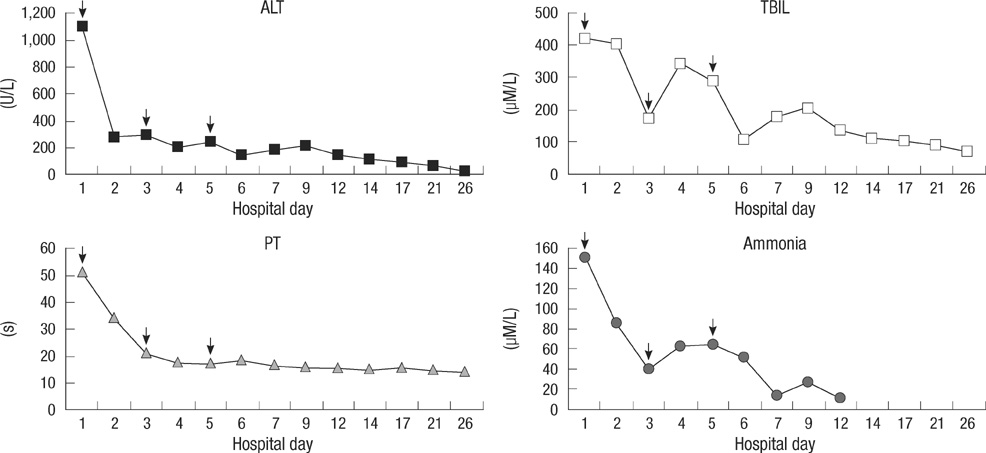J Korean Med Sci.
2011 Jan;26(1):138-142. 10.3346/jkms.2011.26.1.138.
Acute Liver Failure Associated with Occupational Exposure to Tetrachloroethylene
- Affiliations
-
- 1Department of Infectious Disease, the Third Affiliated Hospital, Hebei Medical University, Shijiazhuang, China. zhaocy2005@163.com
- KMID: 1777989
- DOI: http://doi.org/10.3346/jkms.2011.26.1.138
Abstract
- Tetrachloroethylene is a chlorinated solvent that is primarily used in dry cleaning and degreasing operations. Although the hepatotoxicity caused by tetrachloroethylene has been well documented in literature, it is rarely considered as a cause of acute liver failure. We report a case of a 39-yr-old man who was admitted to our hospital for acute liver failure due to tetrachloroethylene exposure. Histological examination of the liver revealed massive hepatic necrosis, prominently, in zone 3 of the hepatic lobules. The patient underwent supportive treatment along with 3 sessions of plasmapheresis, and consequently, he presented a favorable outcome. Repeat liver biopsy performed 6 months after the patient's discharge showed architectural distortion with postnecrotic cirrhosis. Physicians should be aware of the possibility of acute liver failure induced by tetrachloroethylene. Early plasmapheresis can be effective for individuals with sufficient capacity for hepatocyte regeneration.
MeSH Terms
Figure
Reference
-
1. Gold LS, De Roos AJ, Waters M, Stewart P. Systematic literature review of uses and levels of occupational exposure to tetrachloroethylene. J Occup Environ Hyg. 2008. 5:807–839.2. Agency for Toxic Substances and Disease Registry (ATSDR). Toxicological profile for tetrachloroethylene. 1997. Atlanta: U.S.: Department of Health and Human Services, Public Health Services.3. Azimi Pirsaraei SR, Khavanin A, Asilian H, Soleimanian A. Occupational exposure to perchloroethylene in dry-cleaning shops in Tehran, Iran. Ind Health. 2009. 47:155–159.4. Garnier R, Bédouin J, Pépin G, Gaillard Y. Coin-operated dry cleaning machines may be responsible for acute tetrachloroethylene poisoning: report of 26 cases including one death. J Toxicol Clin Toxicol. 1996. 34:191–197.5. International Agency for Research on Cancer (IARC). Dry cleaning, some chlorinated solvents and other industrial compounds. IARC Monographs on the Evaluation of the Carcinogenic Risk of Chemicals to Humans. 1995. Volume 63. Lyon, France: International Agency for Research on Cancer.6. Liu P, Hu YY, Liu C, Xu LM, Liu CH, Sun KW, Hu DC, Yin YK, Zhou XQ, Wan MB, Cai X, Zhang ZQ, Ye J, Zhou RX, He J, Tang BZ. Multicenter clinical study on Fuzhenghuayu capsule against liver fibrosis due to chronic hepatitis B. World J Gastroenterol. 2005. 11:2892–2899.7. Birner G, Richling C, Henschler D, Anders MW, Dekant W. Metabolism of tetrachloroethene in rats: identification of N epsilon-(dichloroacetyl)-L-lysine and N epsilon-(trichloroacetyl)-L-lysine as protein adducts. Chem Res Toxicol. 1994. 7:724–732.8. Ikeda M. Metabolism of trichloroethylene and tetrachloroethylene in human subjects. Environ Health Perspect. 1977. 21:239–245.9. Stewart RD, Baretta ED, Dodd HC, Torkelson TR. Experimental human exposure to tetrachloroethylene. Arch Environ Health. 1970. 20:225–229.10. Dehon B, Humbert L, Devisme L, Stievenart M, Mathieu D, Houdret N, Lhermitte M. Tetrachloroethylene and trichloroethylene fatality: case report and simple headspace SPME-capillary gas chromatographic determination in tissues. J Anal Toxicol. 2000. 24:22–26.11. Lash LH, Parker JC. Hepatic and renal toxicities associated with perchloroethylene. Pharmacol Rev. 2001. 53:177–208.12. Veraldi A, Costantini AS, Bolejack V, Miligi L, Vineis P, van Loveren H. Immunotoxic effects of chemicals: a matrix for occupational and environmental epidemiological studies. Am J Ind Med. 2006. 49:1046–1055.13. Meckler LC, Phelps DK. Liver disease secondary to tetrachloroethylene exposure. A case report. JAMA. 1966. 197:662–663.14. Bagnell PC, Ellenberger HA. Obstructive jaundice due to a chlorinated hydrocarbon in breast milk. Can Med Assoc J. 1977. 117:1047–1048.15. Brodkin CA, Daniell W, Checkoway H, Echeverria D, Johnson J, Wang K, Sohaey R, Green D, Redlich C, Gretch D. Hepatic ultrasonic changes in workers exposed to perchloroethylene. Occup Environ Med. 1995. 52:679–685.16. Maria VA, Victorino RM. Development and validation of a clinical scale for the diagnosis of drug-induced hepatitis. Hepatology. 1997. 26:664–669.17. Yang HN, Kim DJ, Kim YM, Kim BH, Sohn KM, Choi MJ, Choi YH. Aloe-induced toxic hepatitis. J Korean Med Sci. 2010. 25:492–495.18. Kamath PS, Wiesner RH, Malinchoc M, Kremers W, Therneau TM, Kosberg CL, D'Amico G, Dickson ER, Kim WR. A model to predict survival in patients with end-stage liver disease. Hepatology. 2001. 33:464–470.19. Bektas M, Idilman R, Soykan I, Soydan E, Arat M, Cinar K, Coban S, Tuzun A, Bozkaya H, Ormeci N, Ozden A. Adjuvant therapeutic plasma exchange in liver failure: assessments of clinical and laboratory parameters. J Clin Gastroenterol. 2008. 42:517–521.20. Pineda JA, Larrauri J, Macias J, Hernandez A, Guijarro J, Sayago M, Gavilan F, Aguilar J, Lissen E. Rapid progression to liver cirrhosis of toxic hepatitis due to ebrotidine. J Hepatol. 1999. 31:777–778.
- Full Text Links
- Actions
-
Cited
- CITED
-
- Close
- Share
- Similar articles
-
- A Case of Acute Tetrachloroethylene Poisoning Complicated by Acute Renal Failure
- The Difference of the Clinical Patterns between Acute Liver Failure and Acute-on-Chronic Liver Failure
- Malignant Tumors of the Female Reproductive System
- Understanding Acute Liver Failure: A Basic Overview of Definition and Treatment
- Acute liver failure in children




